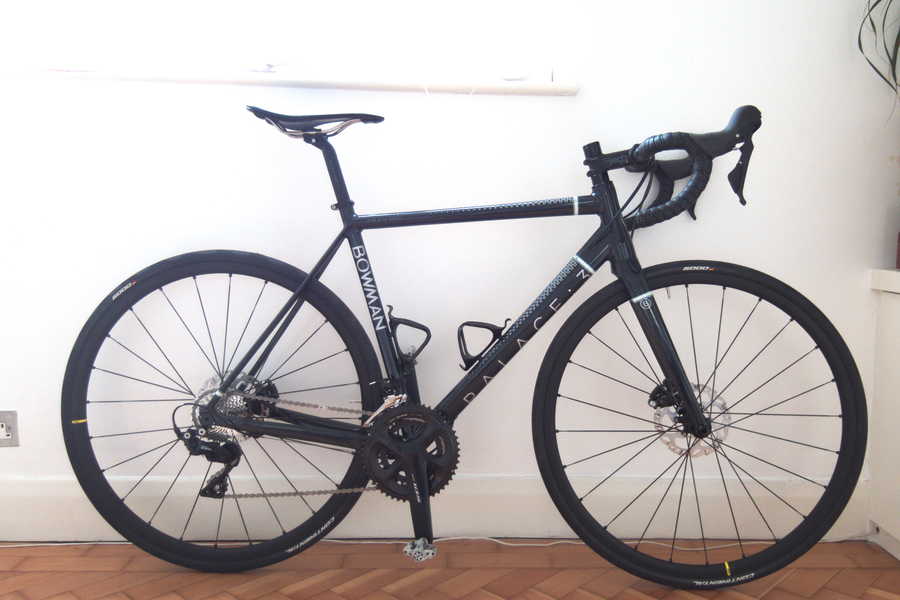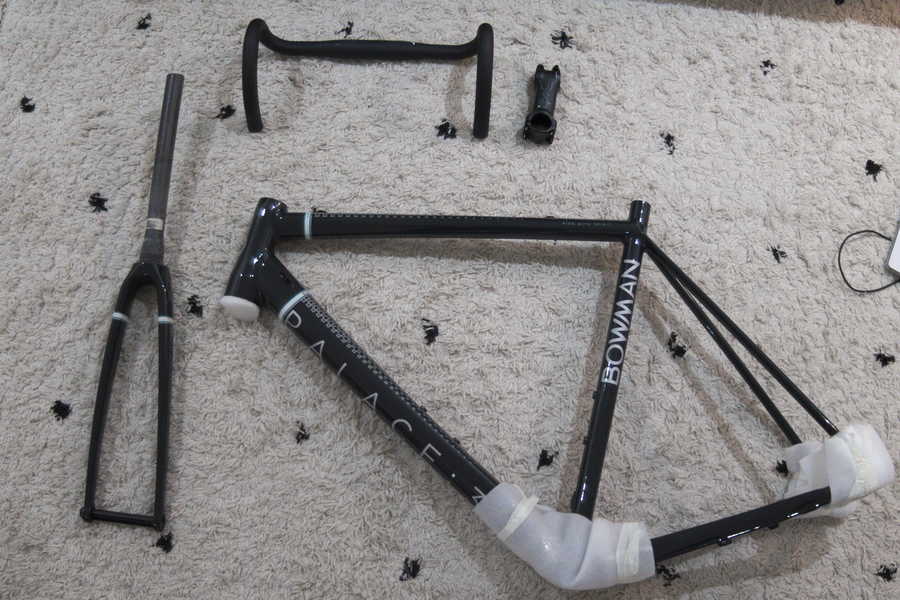
This is my first time building a bicycle from the ground up. I’ve got experience in basic bike maintenance and component overhaul, but nothing like this. The frameset I chose to build the new bike around is new grounds for me as I have no experience with internal cable routing, or disc brakes at all!
Specification
- Frameset: 2020 Bowman Palace 3 56cm (disc brake model)
- Wheels: 2020 Mavic Ksyrium S (disc)
- Groupset: Shimano 105 R7020 (disc)
- Handlebars: Deda Zero RHM 38cm
- Stem: Deda Zero 90mm
- Seatpost: Ritchey Comp 2-bolt
- Tyres: Continental GP5000 28mm
This was always going to be a low-key build. No flashy paintjob or high end brands.
After a few years of riding nothing but steel, I wanted to go back to aluminium just for a change of scenery. Additionally, after wearing my rim brake wheels down in a single winter season a few years ago, I wanted to dip my head into the world of disc brakes.
Shimano 105 would always have been chosen from a price/reliability standpoint. I’m not using my bike long enough to warrant buying a Campagnolo or higher end Shimano groupset for now.
The Build Experience
Frameset

-
DON’T assume that upon delivery, the frameset is ready to have components bolted onto it. There’s a good reason why on the Park Tool New Bike Assembly page the first steps of building are to check frame and fork alignment. The frameset I received in the post suffers from rear brake caliper alignment issues, however the bike brand is local to me, so I was able to send it back for a free caliper mount facing.
-
Internal cable routing for most part is easy on the Palace 3, however installing the left side cable port cover is impossible if you have the brake hose running through the rearmost port. You’ll need to run it through the frontmost port.
-
You’ll need to cut the carbon steerer somehow. I got a bike shop to do it as I didn’t want any carbon dust hanging around my house/garden and I’m not 100% confident cutting perfectly square.
-
Looking on Bowman’s Instagram account to see how the cables are routed with the Palace 3 is a legit technique.
-
I’ve got through so much black electrical tape, fixing the cables to the handlebars, then undoing it and redoing it.
Groupset
-
When purchasing a groupset from Merlin Cycles, you are getting OEM packaging for everything (brown generic carboard boxes), not the fancy blue Shimano packaging. Not a criticism, just an observation.
-
The Shimano documentation that comes with the groupset are essentially leaflets telling you to go to https://si.shimano.com/ for the ’dealer’ manuals. These are the manuals you’ll need if installing components.
-
The shifter cable outers that come with the groupset are cut to length for internal routing, but there’s not enough to run fully through the down-tube of the Palace 3 frame, so you’ll need to buy more.
-
The Shimano CN-HG601 chain supplied with the groupset used a connecting rivet semi-installed to join the chain together. I accidentally cut off the side of the chain with this special rivet on, making it extremely difficult to connect the chain back together. Ultimately I had to throw the chain away as I was also ont as forceful as I should have been with the chain breaker tool, and ended up mangling it. Expensive mistake.
-
Make sure you thread the chain correctly through the rear deraileur, as it can be easy to thread it incorrectly between the two jockey wheels.
-
I had to use the supplied plastic shims with the 105 front deraileur for it to work with the Bowman frame. I then had to get a bicycle workshop to carefully taper the internal side of the shim to successfully clamp to the seat tube. Be careful not to overtighten the clamp with the shim in place! Somewhere on Bowman’s website they reccomend you use a braze-on FD with clamp adaptor.
Brakes
-
Shimano R7020 brifters come with an olive already installed in the hose port, so there’s no need for any additional olives if you’re thinking you’re missing them in the package.
-
Brake hoses come pre-attached to the R7020 calipers and with mineral oil already inside the lengths of the hose.
-
When it came to shortening the brake hoses, I couldn’t find a way of pulling the silver barbs out to reuse them so I ended up buying new ones.
-
There are two types of Shimano barbs. The brass ones are for mountain bike hoses, while the silver ones are for roadbikes (BH90 hose). The brass barbs are marketted as ’Universal’ on some websites, however these won’t going to work with the roadbike hoses.
-
Shimano brake hose (BH90) is incredibly expensive (10 quid per meter).
-
Disc brake bleeding looks totally hassle free and quick in video tutorials, however in practice it is a proper dirty job and takes a very long time if you’re not used to it like I am and have to re-bleed the system to ensure there is no air in the system.
-
Although it doesn’t look like it, the brake calipers come with pre-installed Shimano L03A resin pads.
-
Brake hose is easy to cut perpendicular, and doesn’t require a special tool to cut it squarely. I used a standing knife and got good results.
-
A barb driver tool is required to push the barb into the hose. I couldn’t imagine how fiddly this would be with a hammer and vice. I got one for 20 quid.
-
An adjustable spanner is a crappy tool for opening and closing the nuts on the brake calipers, and can easily scrape off the lovely gloss black finish from them. Best off getting a fixed set of 7mm and 8mm wrenches.
-
The rear caliper flat mount adaptor isn’t supplied with the groupset, unlike the adaptor for the front brake. If you’re running 160mm discs at the rear, you’ll also need to purchase this separately (SM-MA-R1160-DD).
-
Don’t touch the rotors with your hands. The natural oils from your skin will contaminate the rotor and ultimately the pads, causing squealing.
-
You’ll need to purchase a disc brake bleeding kit separately. Mineral oil is also needed, and at time of writing during COVID-19 and Brexit, the official Shimano mineral oil is very hard to find.
Wheels
- There are two types of centerlock rings! One is interally splined, where you can use a normal cassette lockring tool, and the other is externally splined, in which you’ll need the appropriate tool for it, namely the Park Tool BBT-9, or the Park Tool BBT 69.2 if using a ratchet or torque wrench.
Things I weren’t prepared for
- High range torque wrench for correctly installing the bottom bracket and potentialy the cassette and rotors.
- Cassette removal tool for both cassette and rotor lockring.
- Barb driver for brake hoses.
- Hollowtech II tool
- Extra barbs and olives for when you cut too short (and install the wrong type of barbs)
- Extra brake hose
- Extra shifter cable outers
- Rear caliper flat-mount adaptor (SM-MA-R1160-DD)
Items I found invaluable during the build
- Stand - holding the bike up and making it easy to work on
- Set of Park Tool HXS-3 stubby hex wrenches for fiddly or tight spaces
- Park Tool AWS-1 hex wrench for extra leverage
- Black electrical tape for fixing cables to handlebars
- Lifeline torque wrench for torqing the smaller bolts
- Lifeline barb driver
- Motorex Bike Grease 2000 (comes with a nice brush applicator built into the lid)
- Standing knife for cutting brake hoses
- Wire cutters
- Vernier calipers for quickly measuring cable cutting and taping points